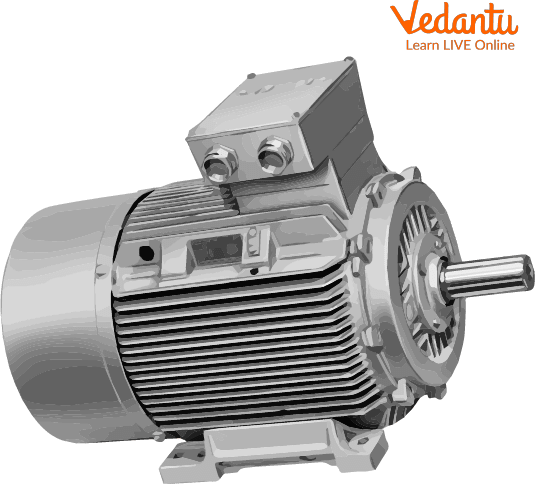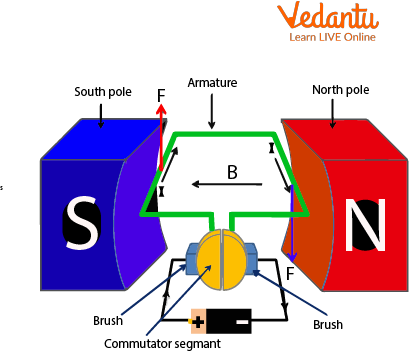




What is an Electric Motor?
Have you ever wondered how a fan works or how a water pump takes water to the top of your House? The water motor takes underground water to meters tall houses just by the use of electricity? How is that even possible? What is the principle behind all these phenomena? The answer is:
All these appliances have one thing in common. What is that? An electrical device that transforms electrical energy into mechanical energy is an electric motor. A large percentage of electric motors work by creating force in the form of torque applied to the motor shaft through the combination of the magnetic field of the motor and electric current in a wire winding.

Electric Motor
Definition
It is a device that rotates. An electrical motor is a machine that converts electrical energy into mechanical energy.
Parts of an Electric Motor
A rectangular coil- the coil is placed perpendicular to the magnet
A strong magnet
Two split rings act as commutators and reverse the current flow through the circuit
The inner side of the split rings is attached to an Axle that is free to rotate
Externally the rings are attached to brushes which in turn connect the whole circuit to the battery
Battery to supply current

Circuit Diagram of an Electric Motor
Working of an Electric Motor
When the battery is turned on the current starts flowing through the rectangular coil in the direction A to B and the electric field generated is from the north to south direction. Therefore, according to the application of Fleming's left-hand thumb rule, a downward force is applied to the coil at portion AB. Whereas by the above principle a downward force is acting on the CD side of the coil hence the coil starts rotating
After half a turn CD replaces AB and the current starts flowing through it from C to D and the electric field applied is from north to south, therefore, CD experiences a downward force whereas AB experiences an upward force.
This hinders the rotation as we want to rotate the coil fully, not partially. And so to overcome this the current is reversed in the circuit per half a rotation.
To change the direction of the current a commutator is used in the circuit. The commutator consists of split rings and brushes attached to the battery
Now, as the coil rotates, the rings also spin with it and When the coil becomes parallel to the magnetic field, the brushes touch the small gap between the rings, and the circuit breaks
Now, due to inertia, the ring keeps on moving and so the opposite end of the ring connects with the positive end of the wire.
Split ring P is connected to coil CD whereas the split ring Q is connected to coil AB. Which in turn reverses the direction of current in the circuit.
Now, the coil CD is on the left side and AB is on the right side. Current is flowing in the coil CD is reversed i.e. from D to C. So, the force on CD is downwards and the force on AB is upwards Thus, the coil keeps rotating
This reversal of electric current occurs in every half rotation and the coil continues to rotate till the battery is turned off.
If a split ring is not used, the coil is rotated half in the clockwise direction and half in an anticlockwise direction Hence, the purpose of a split ring is to reverse the flow of current and make the coil rotate in a single direction.
Some Devices in Which Electric Motors are Used
Washing Machines
Mixers and grinders
Electric fans
Refrigerators
Electric cars
Summary
An electric motor is used for various purposes in day-to-day life from having cooling air in summers to filling water at huge heights. The basis of an electric motor works in magnetic and electric effects. Therefore we should appreciate the presence of this machine happening and make our lives easier.
FAQs on Working of an Electric Motor
1. On what principle does an electric motor work?
The principle of working of an electric motor is when a current-carrying conductor is placed in an external magnetic field perpendicular to the conductor, the conductor feels a force perpendicular to both itself and the external magnetic field. The physical reason behind the production of mechanical force by the interactions of an electric current and a magnetic field. The fleming left-hand thumb rule can be used to determine the direction of the force applied to the conductor. Therefore we can say that an electric motor works on both electrical and magnetic principles.
2. How many types of motors are there?
There are Mainly Two Types of Motors:
AC Motor: it is a motor supplied with alternating current. It consists of a coil that is supplied with an alternating current and that currently creates a rotatory magnetic and electric field for working the motor.
DC Motor: it is supplied with direct current and works on the basic principle of commutators and alternating the current with every half turn.
The above are two kinds of motors that are generally used in various kinds of devices around us.









